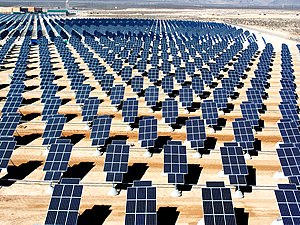
- Image via Wikipedia
A few years ago, Silicon Valley start-ups like Solyndra, Nanosolar and MiaSolé dreamed of transforming the economics of solar power by reinventing the technology used to make solar panels and deeply cutting the cost of production.
Founded by veterans of the Valley’s chip and hard-drive industries, these companies attracted billions of dollars in venture capital investment on the hope that their advanced “thin film” technology would make them the Intels and Apples of the global solar industry.
But as the companies finally begin mass production — Solyndra just flipped the switch on a $733 million factory here last month — they are finding that the economics of the industry have already been transformed, by the Chinese. Chinese manufacturers, heavily subsidized by their own government and relying on vast economies of scale, have helped send the price of conventional solar panels plunging and grabbed market share far more quickly than anyone anticipated.
As a result, the California companies, once so confident that they could outmaneuver the competition, are scrambling to retool their strategies and find niches in which they can thrive.
“The solar market has changed so much it’s almost enough to make you want to cry,” said Joseph Laia, chief executive of MiaSolé. “We have spent a lot more time and energy focusing on costs a year or two before we thought we had to.”
The challenges come despite extensive public and private support for the Silicon Valley companies. Solyndra, one of the biggest firms, has raised more than $1 billion from investors. The federal government provided a $535 million loan guarantee for the company’s new robot-run, 300,000-square-foot solar panel factory, known as Fab 2.
“The true engine of economic growth will always be companies like Solyndra,” President Obama said in May during an appearance at the then-unfinished factory. But during the year that Solyndra’s plant was under construction, competition from the Chinese helped drive the price of solar modules down 40 percent. Solyndra rushed to start cranking out panels on Sept. 13, two months ahead of schedule, and it has increased marketing efforts to make the case to customers that Solyndra’s more expensive panels are cost-effective when installation charges are factored in.
“It definitely puts more pressure on us to bring our costs down as quickly as possible by ramping up volume,” said Ben Bierman, Solyndra’s executive vice president for operations and engineering.
Silicon Valley companies like Solyndra, Nanosolar and MiaSolé continue to receive hundreds of millions of dollars in customer orders and some plan to expand local manufacturing. But the rapid rise of low-cost Chinese manufacturers has made investors — who once envisioned the region’s future as Solar Valley — skittish about backing new capital-intensive start-ups.
“I don’t see another Solyndra being done,” said Anup Jacob, whose private equity firm, Virgin Green Fund, has invested significantly in Solyndra.
The Latest Streaming News: Solar Innovator updated minute-by-minute







